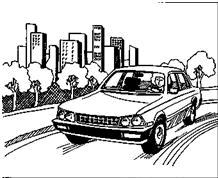Unit 1. Present continuous (I am doing)
A. Study this example situation:

Ann is in her car. She is on her way to work.
She is driving to work.
This means: She is driving now, at the time of speaking.
This is the present continuous tense:
I am (= I’m) driving
he/she/(it) is (= he’s, etc.) driving
we/they/you are (= we’re, etc.) driving
|
We use the present continuous when we talk about something that is happening at the time of speaking:
Please don’t make so much noise. I’m studying, (not I study)
“Where is Peggy?” “She’s taking a bath.” (not she takes)
Let’s go out now. It isn’t raining anymore.
(at a party) Hello, Ann. Are you enjoying the party? (not do you enjoy)
B.
We also use the present continuous when we talk about something that is happening around the time of speaking, but not necessarily exactly at the time of speaking. Study this example situation:
Tom and Ann are talking and having coffee in a cafe. Tom says: “I’m reading an interesting book at the moment. I’ll lend it to you when I’ve finished it.”
Tom is not reading the book at the time of speaking. He means that he has begun the book and hasn’t finished it yet. He is in the middle of reading it. Here are some more examples:
Maria is studying English at a language school, (not studies)
Have you heard about Brian? He is building his own house, (not builds)
But perhaps Maria and Brian are not doing these things exactly at the time of speaking.
C.
We often use the present continuous when we talk about a period around the present. For example: today, this week, this season, etc.:
“You’re working hard today.” “Yes, I have a lot to do.”
Tom isn’t playing football this season. He wants to concentrate on his studies.
D. We use the present continuous when we talk about changing situations:
The population of the world is rising very fast, (not rises)
Is your English getting better? (not does… get)




